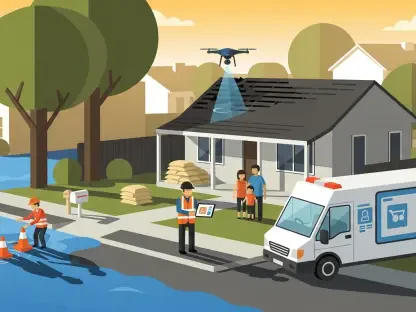In the heart of California, where the scent of smoke often lingers in the air, wildfires have become an unrelenting force, scorching landscapes and upending lives with devastating regularity. Just this year, blazes in areas like the Palisades have razed entire neighborhoods, leaving insurers grappling with an unprecedented challenge of predicting and managing risks in a state where flames seem to defy all boundaries. How can the industry adapt to such chaos? A groundbreaking partnership between California Casualty and ZestyAI offers a glimpse into a tech-driven solution, leveraging artificial intelligence to transform wildfire risk assessment into a precise science. This story uncovers how algorithms and data are becoming the new frontline in protecting communities.
The Escalating Threat of Wildfires in California
California’s wildfire crisis has reached a critical juncture, reshaping the insurance landscape with every passing season. Massive fires, including those in urban-adjacent zones, have exposed vulnerabilities that traditional risk models struggle to address. Many insurers, overwhelmed by soaring claim costs, have reduced coverage or exited high-risk areas altogether, leaving homeowners in a precarious position. The stakes are especially high in a state where environmental threats are intensifying, pushing the industry to seek innovative ways to balance financial stability with the need to protect residents.
For companies like California Casualty, which focuses on serving community heroes such as firefighters, educators, and healthcare workers, the challenge is even more pressing. These essential workers often live and serve in areas most vulnerable to wildfires, making accessible coverage a moral and practical imperative. The California Department of Insurance’s Sustainable Insurance Strategy underscores this urgency, advocating for solutions that maintain affordability while addressing escalating risks. This growing crisis sets the stage for technology to step in as a vital tool.
AI as a Game-Changer in Risk Prediction
Enter artificial intelligence, a force redefining how insurers evaluate wildfire threats. Through a strategic collaboration, California Casualty has adopted ZestyAI’s cutting-edge tools, including the Z-FIRE™ model, to analyze risks with remarkable accuracy. Unlike older methods that primarily focus on rural-wildland interfaces, Z-FIRE™ incorporates urban fire dynamics, assessing how flames can spread rapidly between structures in densely populated areas. Factors such as topography, vegetation density, and building materials are meticulously calculated to pinpoint high-risk zones.
Complementing this is ZestyAI’s Wildfire Mitigation Pre-Fill tool, which evaluates homeowners’ efforts to reduce risk, such as creating defensible space around properties. This data allows for a more nuanced underwriting process, ensuring premiums reflect actual risk levels and rewarding proactive measures. A striking example of this technology’s impact came during recent fires in Eaton, where Z-FIRE™ accurately predicted vulnerable areas, enabling better preparedness. Such precision is proving indispensable for insurers navigating California’s volatile landscape.
Industry Leaders Weigh In on Tech’s Potential
Behind the numbers and algorithms are voices of conviction driving this transformation. Todd Brickel, Senior Vice President and Chief Risk & Product Officer at California Casualty, highlights the importance of reliable coverage for essential workers who face heightened wildfire threats. “Advanced risk assessment is no longer optional—it’s the foundation for serving those who serve others,” Brickel notes, emphasizing how AI tools provide the confidence needed to maintain policies in challenging regions.
Attila Toth, CEO of ZestyAI, echoes this sentiment, pointing to the broader implications of AI in insurance. “By delivering property-level insights, technology empowers insurers to meet regulatory goals while fostering community resilience,” Toth explains. Their shared perspective reveals a crucial insight: AI isn’t just about managing risk—it’s about building a sustainable future where coverage remains accessible. These leaders see data-driven innovation as a bridge between immediate needs and long-term industry stability.
Practical Applications for Insurers Adopting AI
For insurers looking to stay ahead of wildfire risks, integrating AI offers a clear path forward. Tools like Z-FIRE™ enable property-specific analytics, allowing companies to assess individual homes rather than relying on broad, outdated regional data. This granular approach can transform underwriting by identifying subtle risk factors, from neighborhood layouts to local vegetation patterns, ensuring more accurate pricing and policy decisions.
Beyond assessment, AI can support homeowner mitigation by tying premium adjustments to tangible actions, such as clearing brush or installing fire-resistant materials. Insurers can also align with initiatives like California’s Sustainable Insurance Strategy by using these insights to sustain coverage in high-risk areas. Implementing such technology requires investment in training and data integration, but the payoff—enhanced resilience and customer trust—is substantial. This framework provides an actionable blueprint for navigating an increasingly unpredictable environment.
A Blueprint for the Future of Insurance
Looking back, the collaboration between California Casualty and ZestyAI marked a pivotal moment in addressing California’s wildfire challenges. Their use of AI-driven tools like Z-FIRE™ demonstrated that technology could refine risk assessment with unmatched precision, sustaining coverage for vulnerable populations. This partnership also aligned with statewide goals for affordable insurance, proving that innovation and regulation could work hand in hand.
Reflecting on this progress, the next steps for the industry became clear. Insurers needed to prioritize scaling AI adoption, investing in partnerships that enhance predictive capabilities. Encouraging homeowner mitigation through data-informed incentives emerged as another critical focus, fostering a shared responsibility for risk reduction. As environmental threats persist, embracing such solutions offers a way to safeguard communities, ensuring that technology continues to light the path toward a more secure tomorrow.









